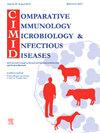钩端螺旋体被TLR2识别,并在自然感染公牛的包皮膜中诱导IFN-β和IFN-λ表达。
IF 2
3区 农林科学
Q4 IMMUNOLOGY
Comparative Immunology Microbiology and Infectious Diseases
Pub Date : 2024-12-27
DOI:10.1016/j.cimid.2024.102291
引用次数: 0
摘要
钩端螺旋体病是一种广泛分布在世界各地的人畜共患病,会造成牛的重大生殖损失。据报道,这种疾病在生殖器官出现,了解这种疾病对于实施适当的卫生措施至关重要。虽然钩端螺旋体可以调节先天免疫,但对公牛生殖器黏膜的反应尚不清楚。本研究的目的是评估钩端螺旋体感染公牛生殖器包皮中先天免疫受体和细胞因子的表达。为此,从阿根廷布宜诺斯艾利斯市Azul区4家没有生殖问题的繁殖公牛中选择常规包皮刮拭样本,之前通过qPCR检测secY基因来评估钩端螺旋体DNA的存在。采用RT-qPCR方法检测钩端螺旋体感染动物包皮标本中TLR2、TLR4、IFN-β和IFN-λ基因的相对表达量,随后使用REST软件对结果进行分析。感染钩端螺旋体的动物与未感染的对照动物相比,TLR2的表达显著增加(4倍),而TLR4的表达无差异。同样,感染动物的包膜中IFN-β和IFN-λ均显著增加(分别为3.5倍和3.1倍)。因此,本研究表明,公牛生殖道感染钩端螺旋体会产生并调节局部先天免疫反应,而钩端螺旋体DNA的存在与TLR2、IFN-β和IFN-λ的表达水平有关。本文章由计算机程序翻译,如有差异,请以英文原文为准。
Leptospira spp. is recognized by TLR2 and induces IFN-β and IFN-λ expression in smegma from naturally infected bulls
Leptospirosis, a zoonosis with a wide worldwide distribution, causes significant reproductive losses in cattle. The genital presentation of the disease has been reported, and its understanding is crucial for the implementation of adequate sanitary measures. Although Leptospira spp. modulate innate immunity, the response in the genital mucosa of bulls is unknown. The objective of this work was to evaluate the expression of innate immune receptors and cytokines in smegma from bulls with genital infection by Leptospira spp. To do so, routine preputial scraping samples were selected from breeding bulls from four establishments in the Azul District, Buenos Aires, Argentina with no reproductive problems, which were previously evaluated for the presence of Leptospira spp. DNA by qPCR detection of the secY gene. The relative gene expression of TLR2, TLR4, IFN-β and IFN-λ in the smegma samples of animals infected with Leptospira spp. was determined by RT-qPCR, with subsequent analysis of the results using REST software. The expression of TLR2 was significantly increased in animals infected with Leptospira spp. compared to uninfected control animals (4-fold), while TLR4 did not show differences. Likewise, both IFN-β and IFN-λ were significantly increased in smegma of infected animals (3.5 and 3.1-fold, respectively). Therefore, this work shows that genital infection of Leptospira spp. in bulls generates and modulates a local innate immune response, with an association between the presence of Leptospira spp. DNA and the expression levels of TLR2, IFN-β and IFN-λ.
求助全文
通过发布文献求助,成功后即可免费获取论文全文。
去求助
来源期刊
CiteScore
4.60
自引率
0.00%
发文量
102
审稿时长
40 days
期刊介绍:
Comparative Immunology, Microbiology & Infectious Diseases aims to respond to the concept of "One Medicine" and to provide a venue for scientific exchange. Based on the concept of "Comparative Medicine" interdisciplinary cooperation between specialists in human and animal medicine is of mutual interest and benefit. Therefore, there is need to combine the respective interest of physicians, veterinarians and other health professionals for comparative studies relevant to either human or animal medicine .
The journal is open to subjects of common interest related to the immunology, immunopathology, microbiology, parasitology and epidemiology of human and animal infectious diseases, especially zoonotic infections, and animal models of human infectious diseases. The role of environmental factors in disease emergence is emphasized. CIMID is mainly focusing on applied veterinary and human medicine rather than on fundamental experimental research.

 求助内容:
求助内容: 应助结果提醒方式:
应助结果提醒方式:


